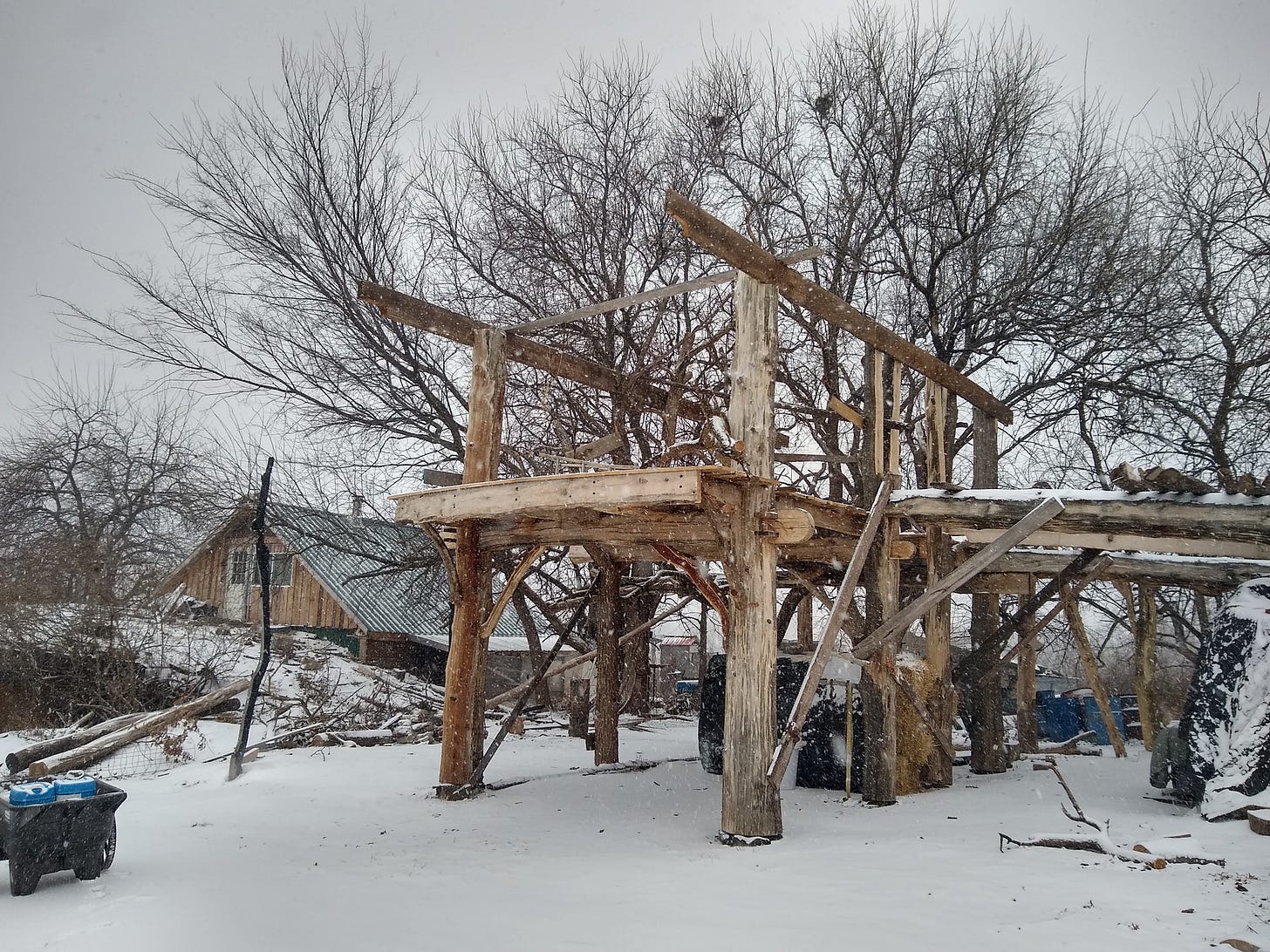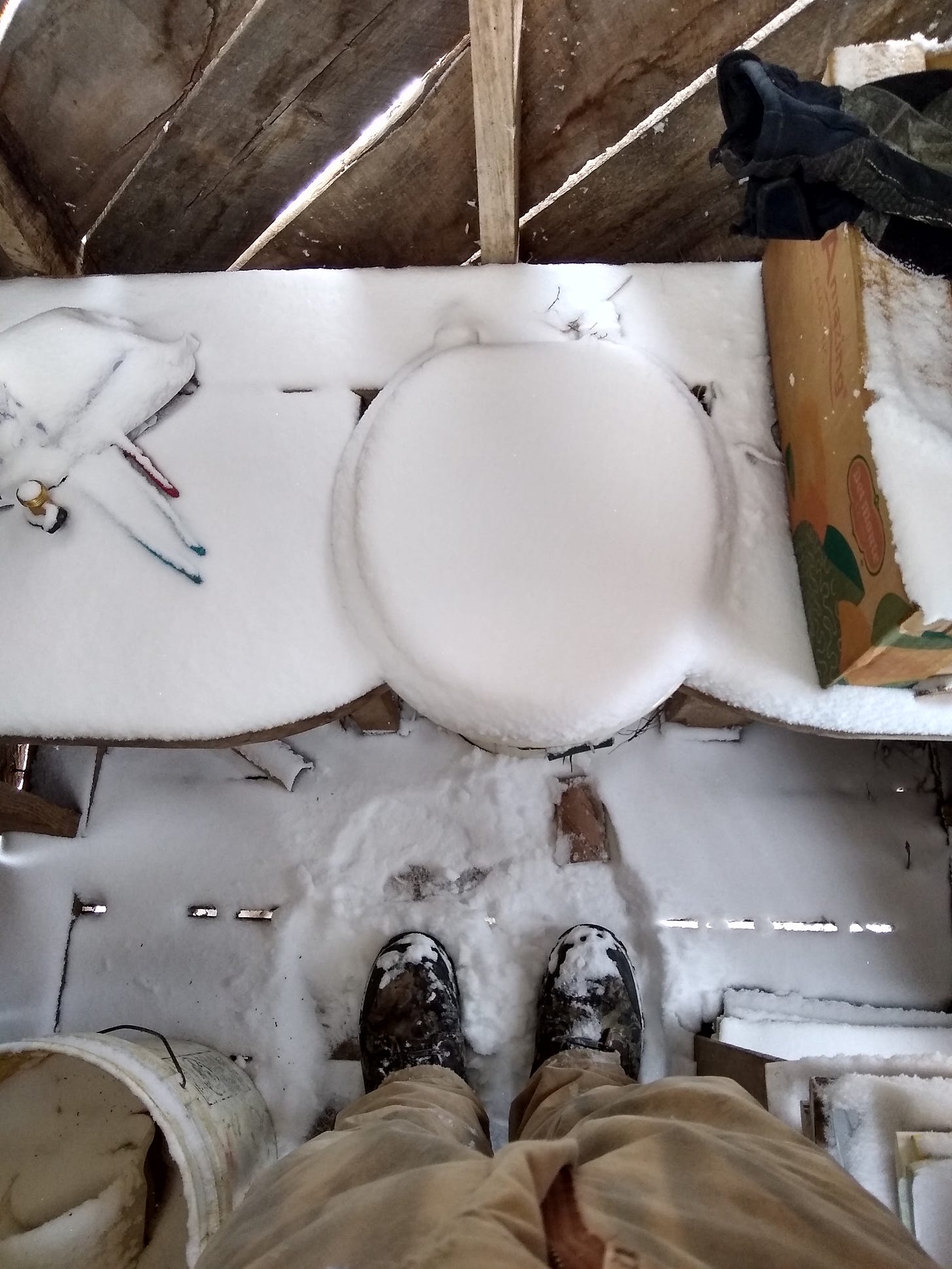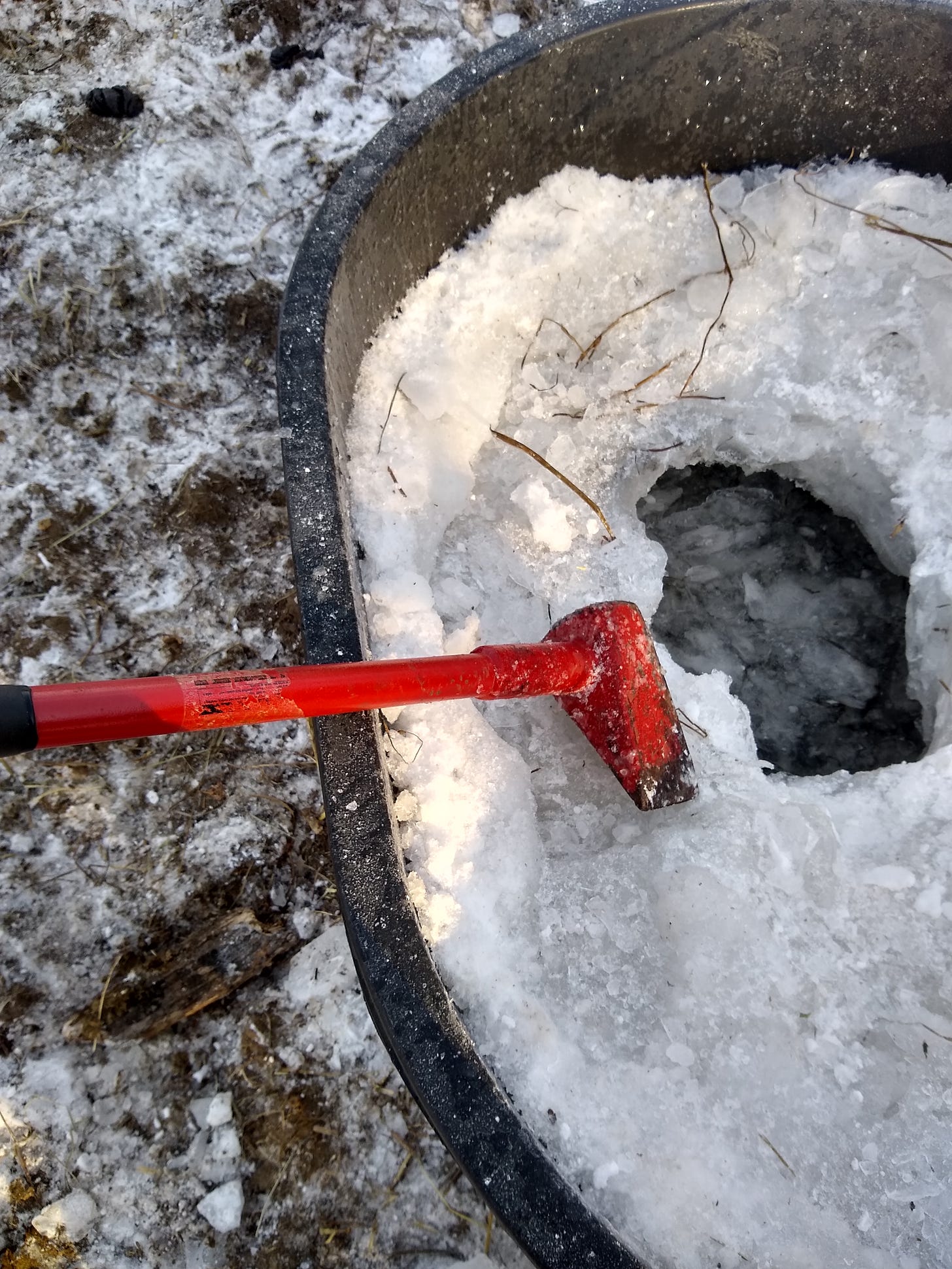Prologue/Observations on the Nature of Water and Various Manures in Late December
In which our entrenched author kicks a few items to determine how liquid they are in consistency and delivers a simple plan for the future of this Almanac.
It has been my intention to kick this writing project off with a year-in-review piece, but I’m not sure that I’m at enough of a place of rest to begin that process. Instead I will treat you to some current complaints.
It has been a frigid few days, short of a week. We are in that sweet spot, when water again flows freely from the collection tanks on the barns, but the ground beneath my boots is firm, frozen, and importantly, not mud. Turds of various origin are frozen enough to handle cleanly. The cow pies in particular are not unlike the polished granite stones used in curling. With melting snow and nights below freezing, I’ll likely have access to a vast ice rink for improving my skills in the days ahead.
Seeing as though I’m embarking on a new writing project, and I’m unclear on who my audience is, I may as well thin the herd early and go into a bit of further detail regarding the problems associated with frozen turds. Now, a frozen goat poop is pretty much indistinguishable from one in any other state; it is merely a pebble of digested grass, and can be largely ignored, so long as it is frozen to the soil or barn floor. The problem is when these goat marbles are free-rolling and they become a major slipping hazard. A cow pie, when frozen, becomes a dense and dangerous discus, which can accidentally bludgeon bystanders when unceremoniously tossed without the necessary attention. Yesterday I realized that it was slightly more efficient, if inelegant, to merely pick them up with my mittens rather than awkwardly seize them with a pitchfork, which works much better on warm leavings. Something about the body geometry, the tines, and the ability for the cow pie to wiggle. The thing to be careful of here, is that sometimes they’re not actually frozen, but quite fresh. I recommend checking for steam.
Our swine herd does its best to be fastidious with their droppings and choose to pick a spot outside their shelter as their communal commode. This makes for an ease of harvest, when necessary. All is good on that front. Chicken manure mostly drops at night, when they’re roosting in the poultry barn, and for this reason I’m able to get away with in-situ deep bedding style composting. I will occasionally clear out frozen chicken leaving by hand in the nest boxes. A frozen bird turd takes on a pointed form, and they can be kinda sharp, believe it or not. The most distressing form of frozen manure, for me, is that which my own body has produced.
For those of y’all who are unaware, we utilize a bucket-based humanure system here. A privvy. An outhouse. We shit in buckets, ok? And then the buckets are moved through an effective and safe composting arrangement that I may describe in some subsequent newsletter. For a decade now, I have refused to integrate, uh, posterior evacuation, into my indoor life. I figure, if a pig has the common sense to leave its barn to drop a load, so should I. Perhaps one day society will look back on indoor defecation as a brutish and ignorant practice, but for now, bucket-shitting is not as well appreciated a practice as it could be in the affluent Western world.
It is not without its problems, however. Particularly in the cold. Firstly, there’s the discomfort, which can be overcome. We’re getting to know each other a little more here, I may as well tell you that I basically poop first thing in the morning. When it is darkest and coldest. While it’s vital for me to keep my core temperature up throughout the workday, I will forego any form of overall, coverall, or full body suit for my morning ritual. There’s some research out there that I will relate to you third hand about the health benefits of spending a few minutes in deep cold daily, and so I do not rush the process, I relax, I do what I came to do, and I consider the process a form of mindfulness meditation. After that, the coffee is well steeped and I can put on as many pairs and configurations of pants as I’d like. The problem, and I’m going to be graphic in no uncertain terms here, is that things tend to stack up into pillar form this time of year, and buckets have a little less than half their capacity for dung collection in these frigid weeks. Don’t push it, don’t test the capacity limits. Trust me on this one, folks. But onto the frozen state of another form of matter, water.
Much of my time during these brutal cold snaps are spent troubleshooting water for our livestock. Keeping 5 cows in fresh water alone can prove difficult on sub-zero days without the benefit of or desire for an electric immersion heater. Our nearest frost free spigot is maybe 300 feet away. When several days of polar air are strung together like this, that amount of hose can basically be used one time to fill the trough before it becomes choked with ice. Of course, the hose can be cleared of ice with a funnel, several kettles of hot water, and some patience. Often the hot water will overflow the hose and provide the exciting sensation of frost bite and burns on the same hand! In the time it takes to thaw a hose out using this technique, several 25 gallon sled loads of water can be hauled back and forth, and so that is my primary go-to when the tanks are frozen… so long as the “frost free” spigot remains frost free, which inevitably, it does not.
In addition to the 5 cows, there are two groups of dairy goats, three groups of swine, and around 80 birds in our mixed species poultry flock that also need liquid water twice daily, plus the five to ten gallons our household uses daily for domestic purposes. When the snow drifts are slight and easier to traverse, we probably spend an hour or so daily on obtaining and transporting water in the winter time. The thicker and deeper the snow gets, the longer these trips take. Then there is mixing feed, offering bedding, filling hay mangers, collecting eggs before they freeze, breaking up kindling, hauling firewood, taking off three pairs of pants (six pantses total) to use the outhouse, milking cows in the arctic air, and so on and so forth.
In order to provide fresh water to our livestock, the ice must occaisionally be cleared from their dishes and troughs. The smaller vessels can be easily cleared with a hand sledge, but the 130 gallon cattle trough takes a bit more effort, usually delivered with a heavy maul or chipped at with a dibble bar. I will then typically skim the floating ice chunks out with my un-gloved hand, as this keeps my mittens dry enough for the rest of the chores. And yet, while some form of skimming tool would leave me less exposed, I figure that if the cows are putting their snouts to it, I can touch it a little too.
Using a woodstove to melt ice or snow is not an efficient choice when we have to provide a bare minimum of 70 gallons of liquid water daily. And I was surprised to learn how much air is in snow…
And so, when folks have the chance to visit our project in the growing season, take a look at all the work that needs to be done and say, “At least things slow down for you in the winter time…”, I want those folks to know that they are wrong. I may be moving slower, no doubt, and some of the tasks are different for sure, with less daylight to accomplish them in, which is why I have been waking up pre-dawn, making my first sled trip of the day with a headlamp. But life is no less hectic. I am not looking at seed catalogs yet. I have not gotten bored, just exhausted. Looking to the dormant trees and wild seed slumbering in the subnivean soil for inspiration, I soon hope to go to that place of reflection, recuperation, and hibernation, but I’m very much not there yet.
I suppose that my inner romantic thought these winter days would be spent in a rocking chair bathed in the flickering light of the woodstove, surrounded by the bounty of our harvest, maybe doing some handwork, or reading. I do have a rocking chair, albeit one covered in the frozen and manure stained coveralls that I’ll be back inside of later tonight while I finish up evening chores. And as a gentle southerly breeze brings in the humid sent of melting ice and mud, I expect tomorrow’s list of priorities to shift from the cold and hard type to the sloppy and balmy responsibilities of hauling bedding, mulching pig sties, and flinging a few loose cow pies out of the loafing shed.
Moving forward, my hopes for this writing project moving are to depict a fair and realistic view of this simple, seasonal life. I will warn you of the pitfalls (and other things) I’ve stepped in, I will share what I’d wish I’d learned sooner, and I will do my best to call bullshit on the glamorization of what is often a challenging, arduous, and financially unrewarding lifestyle of choice. I will offer a fair critique of food and farming trends and buzzwords, or at least acknowledge the personal biases I am of aware of when doing so. I hope this almanac will serve to both encourage and discourage the right people from engaging in this important relationship between people, land, and food. For me, sustainable agriculture is a joy and a calling, but I suspect there may be some type of un-examined pathology there.
Over time I hope to develop a practice and rhythm as a writer that will primarily serve as a record as well, a document that rolls with the seasons, be they ice season, snow season, mud season, rain season, pretty flower season, hot as hell, or mud season part two. Hold on to your pantses, y’all, it’s going to be a bumpy jaunt in the old turnip cart.
Very truly yours,
BB





Great writing Ben. I can see the cow pies and feel the cold when you talk about moving water in way below freezing temps. Ouch. Not to mention sitting down in the outhouse.
Dear Ben, you are. a talented writer and farmer. Keep up the great writing. May the winter be productive for you.